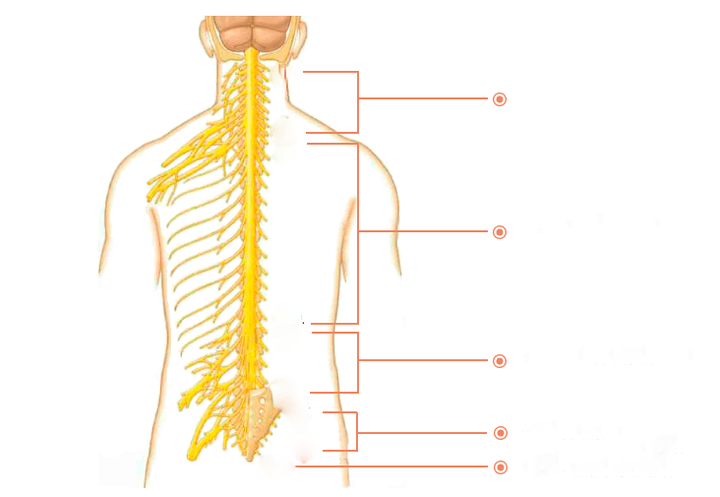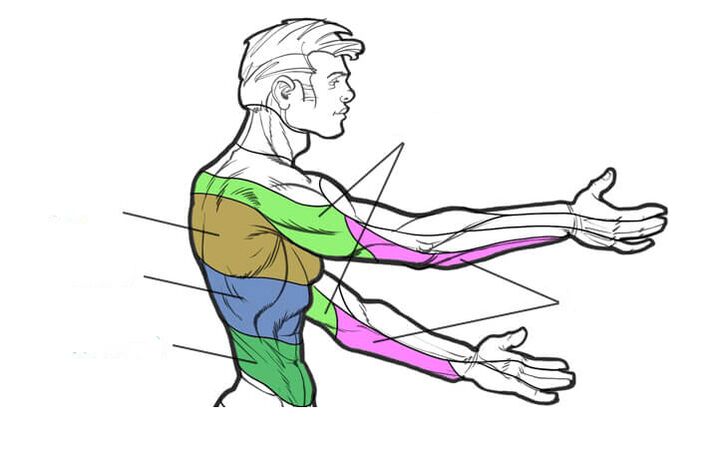The thoracic spine has a peculiarity: the ribs are attached to it. Because of this, it is less mobile than the neck and lower back. Accordingly, osteochondrosis in the thoracic region develops less often, according to the principle: "less mobility - less wear. "But it develops less often, this does not mean that it flows more easily. And indeed it is. It's about chest pain. Since the pain zone of the thoracic spine coincides with the zone of the heart, the symptoms are often mistaken for angina pectoris or myocardial infarction. No wonder they say about thoracic osteochondrosis that it is a "chameleon". After all, you can pretend not only to have heart disease, but also disease of the lungs, liver, stomach, gallbladder, or pancreas. And here you can not make a mistake and miss a heart attack or other serious illness, for example, pathology of the mammary glands in women. Mistakes like this are costly, even if it works out in the end. After all, this can "drive" a person to severe stress. That is why it is very important to find an experienced and knowledgeable doctor who understands everything and distinguishes the symptoms of thoracic osteochondrosis from other pathologies. Symptoms of osteochondrosis of the thoracic region are generally divided into two categories: radicular and reflex.
root symptoms
They arise due to the effect on the nerves leaving the spinal column.
spinal nerves

There are many nerves coming out of the spinal column. They are called spinal nerves. Each of these nerves gradually branches out and follows a certain area of the body with clearly defined boundaries. This area is called the zone of segmental innervation. Each vertebra, disc, nerve and zone are numbered in strict correspondence with each other. If the nerve is affected, the symptoms will appear in the area of segmental innervation corresponding to this nerve, and not just anywhere, in an arbitrary place.
Radical symptoms include:
- Diminished or loss of reflexes;
- Violation of sensitivity;
- muscular weakness;
- Center pain.
Innervation zones of the thoracic segments
Osteochondrosis D1-D2- causes pain in the shoulder, collarbone and armpits.

Osteochondrosis D3-D6- Causes pain, tight character, in the upper chest. It simulates pain in the heart, an attack of angina pectoris. In women, it causes pain in the mammary glands.
Osteochondrosis D7-D8- Causes waist pain at the level of the solar plexus. Simulates pain in the stomach, liver, gallbladder, or pancreas. Reduces upper abdominal reflexes.
Osteochondrosis D9-D10- Causes pain in the hypochondrium and upper abdomen. Sometimes it mimics the so-called "acute" abdomen - a sharp pain in the abdomen. Decreases mid abdominal reflexes.
Osteochondrosis D11–D12- Causes pain in the groin area. Simulates pain in women's diseases, appendicitis, intestinal diseases. Reduces lower abdominal reflexes.
reflex symptoms
Unlike root symptoms, reflex symptoms do not have clear boundaries. These can be: shortness of breath, shortness of breath, pain during inhalation-exhalation, chills and "goosebumps" on the skin, intercostal neuralgia, chest girdle pain. Dyspepsia is often observed: appetite worsens, nausea, heartburn, bloating and stool disorders occur. Due to pain, sleep is disturbed, insomnia and the feeling of not having slept enough occur. It is difficult to move, especially in the morning. The coordination of movements is disturbed, this is reflected in the gait. General weakness, weakness. Violations in the sexual sphere. Irritability. rapid fatigue. There are various types of pain. Pressing pains in the chest. Pain between the shoulder blades. Pain in the hypochondrium. Pain when raising the arms. Pain when bending over or trying to straighten up. Pain between the shoulder blades. In general, pain in osteochondrosis of the thoracic region can be divided into two types.
back pain- Prolonged moderately pronounced pain in the back and chest with periods of intensification and attenuation.
Back- sharp pain "lumbago" in this area.
- Symptoms of osteochondrosis of the thoracic region depend on the stage of osteochondrosis.
- They are aggravated by stooping or trying to straighten up.
- Symptoms often appear after 35-45 years.
- It occurs about 3 times more often in women than in men.
You, of course, noted that the root symptoms are clearly defined and the reflex symptoms are very blurry and nonspecific. And as you know, everything that does not have clear definitions serves as a comfortable cover for professional helplessness. This applies, among other things, to reflex symptoms and such a favorite concept among doctors as "age-related changes". Surely many of you are familiar with the situation in which the doctor explained the problem by "reflex" or "age-related" processes. Most people at such times rightly believe that the doctor simply cannot understand what is happening and is trying to hide his incompetence in the fog of these "magic words".
There was once a popular phrase: "Every accident has a name, surname and title". Each disease has its own unique symptoms. And the doctor's duty is to know them clearly. And then there will be no need to let the fog in and blame osteochondrosis of the thoracic region for everything. Now you understand how important it is to find an experienced and knowledgeable doctor. Both the correct diagnosis and the good results of the treatment will depend on this.
Diagnosis is the key to proper treatment
To date, there are several modern hardware diagnostic methods of osteochondrosis. The most accurate of these are MRI and CT scans. But the main method is still clinical diagnosis: this is when an experienced doctor compares data from at least three sources: patient complaints, MRI results, and the symptoms that he revealed during the examination. This allows you to make the most accurate diagnosis and create an effective individual treatment program.
Treatment
As he will understand, osteochondrosis is a real "tangle" of symptoms, unraveling it, the doctor will save him from pain and distress. But it is not possible to eliminate changes in the vertebrae and discs. Therefore, the words "treatment of osteochondrosis" must be understood correctly. If you are interested in eliminating pain and other suffering, then yes, it is very possible. And if you conduct an academic discussion on the topic of returning the vertebrae and discs to their original appearance, "like a newborn child", then no, the past cannot be returned. You need to be realistic, and then you will not fall for the bait of scammers.
Don't fall for the scammers!
It is impossible to return the vertebrae and discs to their original appearance!
What is the main method of treatment?
Gentle manual therapy is the main type of treatment for osteochondrosis of the thoracic region. It's like an antibiotic for pneumonia: you can't do without it. Other types (massage, medication, physical therapy, and exercise therapy) are ancillary.
How does gentle manual therapy work?
The nutrition of the discs is directly related to the muscles that surround the spine. In addition, the back muscles themselves are one of the constituent causes of pain in osteochondrosis of the thoracic region. Gentle manual therapy is a special method that allows you to return the muscles to their natural physiology, eliminate spasms, muscle impingement and improve disc nutrition.
The intervertebral discs are the only part of the body that does not have blood vessels and is nourished by the proper functioning of the muscles.
In addition, when treating with the help of the hands, the chiropractor:
- remove the load from the affected vertebrae and discs and distribute it correctly;
- relax the muscles and help them return to normal;
Thus:
- save the patient from the clamps;
- improve disc power;
- restore the motor functions of the body;
- normalizes blood circulation.
The manual impact mobilizes the internal forces of the body and sets in motion self-healing mechanisms.
The treatment is absolutely safe.
Prevention
To avoid relapse, create comfortable conditions for sleep and work. Watch your weight and proper nutrition. Keep up your physical activity. But the main thing is not to neglect your health and not to save on it. Don't let things go by themselves. After recovery, try to do at least one maintenance session of gentle manual therapy once every three to six months; this will reduce risk factors. Do not forget, neglected osteochondrosis leads to complications - protrusion and herniated disc. Remember: your health, first of all, needs it!
Running osteochondrosis leads to complications - protrusion and herniated disc.













































